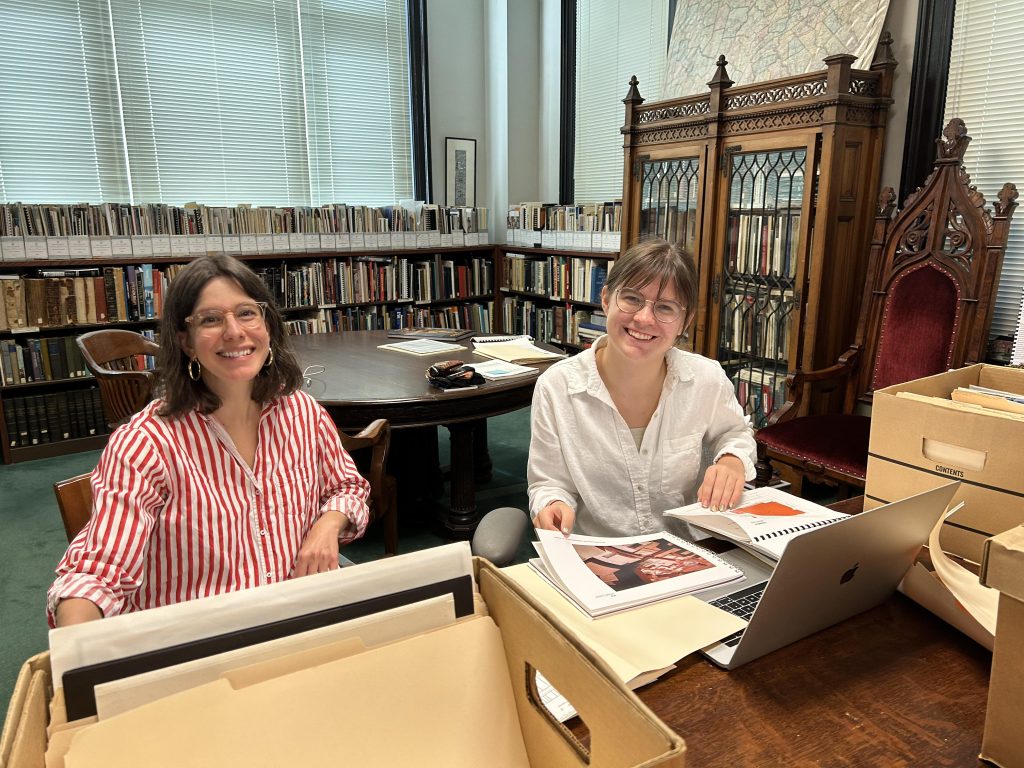
Internship Spotlight: Reflecting on the History of the Fifth-Forbes Preservation Battle

PHLF Archivist Anna Samuels (left) and Zoe Trexel (right), a library intern from Kenyon College, spent the summer 20024 processing our organization’s collection of files of the Fifth-Forbes preservation battle.
Over the summer, our organization welcomed Zoe Trexel, an anthropology major at Kenyon College in Gambier, Ohio, to work alongside our Archivist Anna Samuels in the James D. Van Trump Library & Archives.
Zoe helped to review and reprocess the Fifth & Forbes Collection which highlights the preservation battle surrounding our organization’s opposition to former Mayor Tom Murphy’s plan for Downtown Pittsburgh, which would have seen the demolition of 64 buildings in Downtown.
In this essay, Zoe reflects about the ways in which her background in anthropology informed her understanding of Pittsburgh’s preservation history.
———————————————————————————————————————
By Zoe Trexel
After visiting a few of my college friends’ hometowns, we started describing ourselves as “place-memory people.” This invented phrase encapsulates how deeply we as individuals value our hometowns, typical local haunts, and the landmarks of our childhoods.
Growing up in Pittsburgh was certainly a formative experience. It is impossible to explore the city without understanding how the contours of the landscape, and the skeleton left behind by its industrial history, partition an already small city into even smaller neighborhoods with their own character. I treasure all the quirky neighborhoods, eccentric traditions and the distinctive “yinzer” vocabulary. I have learned to love it even more as I have been able to share it with other people. Pittsburgh is particularly remarkable because of the contradictions ingrained within its culture, the most evident being the importance of its past and the simultaneous trend towards some vague idea of “modernization.”
This summer, I was given the opportunity to explore this juxtaposition in the archives of the Pittsburgh History & Landmarks Foundation. Each day, I delved into documents that connected my love of my hometown to my anthropological interest in the desire to preserve the past societies and structures for posterity. The particular collection I dealt with centered around the Fifth and Forbes controversy, in which former Pittsburgh Mayor Tom Murphy proposed a plan that would have destroyed a significant number of historical buildings and removed many local small businesses in favor of a vast mall contracted through a Chicago developer.
At first, sorting through the documents seemed like a somewhat daunting task. Without a full understanding of all the different factions and individuals with a stake in the fight against Murphy’s plan, it was unclear exactly how the documents fit together. However, as I read through the archival material, the story started to piece itself together.
The deal intended to take advantage of Pittsburgh’s push towards progress to the detriment of its own citizens and integrity. As I explored further, it became clear to me that the Pittsburgh History & Landmarks Foundation played a pivotal role in this narrative and I was fortunate enough to work in the very office that pushed back against Murphy’s plan. After completing the project, I reorganized the collection’s archival system in a more logical manner. The main characters of this battle, from large task forces and powerful politicians to private citizens with an interest in the survival of this city, were put at the forefront of the new organizational system.
As an anthropology major at Kenyon College, I feel that historic preservation battles such as Fifth and Forbes can be better understood through an anthropological lens. Place is important to humans because it marks the way we interact with our worlds and to others. In the same sense that archaeologists attempt to understand the lives of past societies by studying their spaces, we are able to use the same methodology to gain a broader understanding of the intricacies of our everyday lives and what it means to inherit structures past generations have created. The push to maintain as many historical façades as possible and preserve local businesses highlights a reverence for Pittsburgh’s past and a concurrent yet seemingly contradictory dedication to its future.
I believe this not to be a glorification of the industrial city that came before, but a realization of the need to maintain the physical structures of the past in order to understand how we have arrived at the present moment. The spaces we inhabit not only inform us about our way of life but dictate it, thus permeating human memory and allowing us to cherish others and the lives we’ve lived in these spaces.
